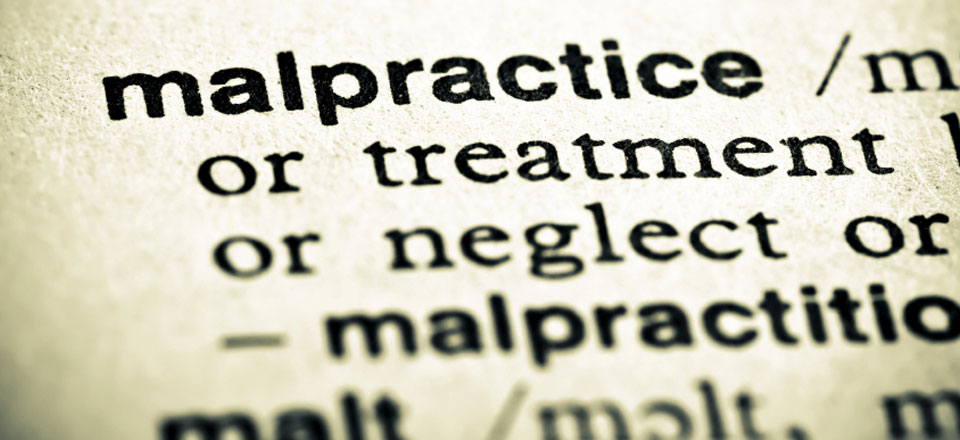Medical negligence is a negligent act or omission by a health care provider in which care provided deviates from accepted standards of practice in the medical community and causes injury to the patient. Standards and regulations for medical malpractice ensure that each and every patient will receive a reasonable standard of care regardless of their age, sex, or race. Medical professionals are required to maintain professional liability insurance to offset the risk and costs of lawsuits based on medical malpractice.
Problems related to medical negligence are widespread
In a recent study by the Harvard School of Public Health, Health Policy and Managment, entitled Accuracy of the Medical Malpractice System: Relationship Between Claims, Errors, and Outcomes of Litigation (2005) the researchers concluded that virtually all claims (97%) involved identifiable adverse outcomes, and most involved serious injury (55%) or death (26%). In 63% of claims, the adverse outcomes were due to error. Reviewers judged the error determination to be a close call in 24% of claims. Plaintiffs received compensation in 57% of claims. The researchers concluded that the impact of frivolous lawsuits may be overstated by physicians and other health care providers.
The Doctors Company, a large physician-owned medical malpractice insurance company, conducted a study of closed or settled claims to determine what percentage of claims were due to system errors. Looking at claims from 2004 to 2006, the researchers found that system errors contributed to 30 percent of settled claims. The most common problems involved medication-related errors (32 percent), communications errors (27 percent), healthcare associated infections (18 percent), medical records errors (13 percent) and identification errors or wrong site surgery (5 percent).
So why does this problem exist? The problem has multiple sources. For example:
In the hospital, residents are required to work excessive hours without adequate supervision. It is estimated that their longest period without sleep during their first year of residency was an average of 37.6 hours, and during a typical work week, they worked an average of 56.9 total hours in on-call shifts in addition to their normal working hours.
A recent survey of doctors and other adults released in the New England Journal of Medicine found that more than a third of the doctors said they or their family members had experienced medical errors, most leading to serious health consequences. The cost to society in terms of disability and health care costs, lost income, lost household production and the personal costs of care are estimated to be between $17 billion and $29 billion. In contrast, the medical liability system costs $6.7 billion annually, about what is spent on dog food each year.
As a result of studies such as the ones identified above, increasingly, hospitals areadopting policies that require them to forgo charges for treatment that involves preventable serious medical errors, also known as “never events.” In its 2008 Hospital Professional Liability and Physician Benchmark Analysis, insurance broker Aon said that “never events” account for one out of six medical malpractice liability claims. As of October 1, 2008, Medicare will no longer pay hospitals for procedures that involve eight types of serious medical errors including operating on the wrong person or wrong site. Vermont’s hospital association said that there should be no payment for eight types of errors. Hospitals in Minnesota and Massachusetts also have adopted never-event policies. Some health insurers are following Medicare’s lead.
It is important to hold health care professionals responsible for their preventable mistakes. Doctors do not police themselves. According to data from the National Practitioner Data Bank, which records all claims paid against physicians, just 5.1 percent of doctors account for 54.2 percent of the malpractice payouts, Of the 35,000 doctors who have had two or more malpractice payouts since 1990, only 7.6 percent of them have been disciplined. And only 13 percent of doctors with five medical malpractice payouts have been disciplined.
Most Recent Medical Malpractice News
Increase in Babies Born to Opioid Addicted Mothers
On August 10, 2018, the U.S. Centers for Disease Control and Prevention (CDC) reported an increase in babies born to opioid addicted mothers (also known as mothers with opioid use disorder). Hospital discharge data show [...]
FDA Restricts Sales of Essure Birth Control Devices
The FDA has restricted sales of Essure birth control devices, according to the New York Times and other news sources. Sales of the contraceptive implant will now be limited to medical providers who agree to [...]
The Opioid Epidemic’s Hidden Hospital Costs
Hospital losses from increasing medical negligence claims are among the opioid epidemic’s hidden costs. The opioid crisis has overtaxed hospitals throughout Pennsylvania and across the country, increasing the potential for malpractice claims against hospital physicians, [...]
Allegheny County’s Opioid Overdose Deaths
The Allegheny County Coroner’s Office records Allegheny County’s opioid overdose deaths on County death certificates. In 98% of Allegheny County overdose deaths, the specific drugs involved in a fatal overdose are listed on the decedent’s [...]
Philadelphia Opioid Safe Injection Sites
On January 23, 2018, City of Philadelphia officials decided to move forward with plans to establish Philadelphia Opioid Safe Injection Sites. Safe injection sites for users of heroin, fentanyl-laced drugs, and other street opioids are [...]
Official Allegheny County 2017 Drug Deaths
The Allegheny County, PA Coroner’s Office reports that official Allegheny Country 2017 drug deaths exceeded those in 2016. The County’s drug deaths from 2016 also exceeded those in 2015, which exceeded those in 2014, an [...]







